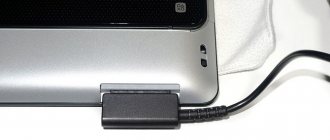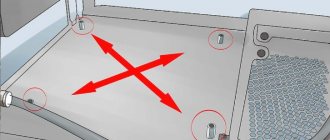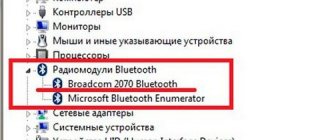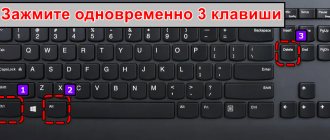If the laptop does not charge the battery, and the charger is connected, most users tend to change the battery. But this is not the only way to solve the problem. Even if the nominal capacity of the battery has become smaller than stated by the manufacturers, there is no need to rush to change it.
To determine that the battery, when properly connected, has stopped charging, you need to move the mouse cursor over the battery icon in the lower right corner of the monitor. If the “connected, charging” message does not appear, it means it has stopped working. There are three ways to solve the problem.
Battery connected - no charge
Here the age of the device and its manufacturer do not play any role. Laptops from Samsung, Xiaomi, Prestigio or other companies are equally susceptible to this problem.
The defect is revealed as follows: in the notification area next to the icon indicating the charge, a message is displayed with the text: “Connected, not charging.” Windows 10 users will see a slightly different message: “Charging is not working.” The first cause of the problem is software anomalies, which only a specialist can understand. What can you do on your own? The universal method is to “reset” the BIOS.
This is done in 10 steps:
- Turn off the device completely.
- Remove the battery from the outside.
- Disconnect the gadget from the network.
- Hold down the power key (1 minute).
- Connect the device to the network (without battery).
- Press the power key and go to BIOS.
- Reset the settings to factory defaults (menu EXIT - Load Defaults).
- Save changes and turn off the gadget.
- Disconnect the power supply cord from the laptop.
- Return the battery to its place, connect the charger.
In the end, all that remains is to turn on the device (user settings will be saved) and observe its operation. If everything is done correctly, then Windows will delight the user with the message: “connected, charging.” In case of failure, it is worth studying the following sections of this material and applying other methods of troubleshooting.
Useful to know: What to do if the laptop does not turn on: 6 main situations and ways out of them
System errors
Manufacturers usually claim that charging problems are not caused by the operating system. But in practice, many people talk about this - there are many such discussions on forums. The problem is the same - the laptop charges only when it is turned off.
Users note that this happens when changing the operating system to another. Indeed, if you install at least Windows 7 on an old computer that was purchased during Windows XP, not to mention versions 8 or 10, then such a problem may appear. The point is the incompatibility of hardware and software.
Laptops sold in stores are adapted to work with modern operating systems. But hardware quickly becomes outdated, and programs are improved, and after a few years compatibility is lost - new systems no longer support working with old equipment.
Therefore, if your battery stopped charging precisely after changing the system, this is a reason to think about it. There are also several possible solutions here. The first is to return to the old system, with which everything worked fine. The second is to update the computer itself to a modern model, if using a new system is very important.
We looked at the most typical reasons why battery charging does not start correctly or does not start at all. Of course, various other situations are possible, so write in the comments if you have encountered these. Any experience will be useful for our readers.
New laptop - battery does not want to charge
Devices “only from the assembly line” have a pre-installed licensing system. In this case, the battery of a completely new laptop does not charge for 2 reasons: a factory defect or incorrect initialization of the battery.
You can help your device like this:
- turn it off;
- disconnect the gadget from charging;
- remove the battery;
- hold the ON key on (20 sec);
- return the battery to its place;
- connect the charger.
All that’s left to do is turn on the device and make sure it’s working correctly.
A couple more tips for those whose device has a removable battery. For example, an elementary method:
- completely turn off charging;
- remove the battery from its compartment;
- press and hold the power key for 1 minute.
Then you need to follow the steps sequentially: return the battery - plug in the charger - wait 15 minutes and turn on the device. All.
New variation of the previous method:
- When the device is turned on, turn off charging and do not touch the battery.
- Press and hold the power key until the device turns off.
- Connect the power supply.
- Wait a quarter of an hour.
The procedure ends with turning on the device. Thus, you can deal with the problem yourself, without involving a specialist. 3 more typical problems and their solutions are discussed below.
Checking settings
Windows 10
Start > Settings > System > Power and sleep > More power options (Related options) > Power plan settings . For a “balanced” option, the values should be as in the photo:
Be careful about your battery, display, and sleep settings. For example, battery performance can cause problems if you turn off your computer when the charge level is too low, or if you set the battery's low charge level to a percentage that is too high. Try restoring the default power profile settings and reconnecting the charger.
Driver Update
Start > Device Manager > Chargers: Microsoft ACPI Compliance Control Method Battery > Update driver via right-click > Reboot .
Battery overheating - causes, consequences, solution
The problem arises if the owner of the gadget did not keep the cooling system clean. As a result, dust accumulates in a dense layer and the battery, along with the entire device, simply overheats. Also, this defect may occur if you use the device in stuffy/dusty rooms. During the hot season, this reason is one of the first on the list of why the laptop battery does not charge.
How to determine if the battery is overheated? The device is turned on and charges quite normally for a certain period of time, and then the message “battery is not charging” appears. This is a sure signal that it is overheating. What are the solutions? First of all, it is necessary to clean the device from dust accumulations. To do this, you should contact a laptop maintenance specialist.
In addition, special laptop stands will save you from overheating the battery. They help cool the device as a whole, and therefore extend the life of the gadget.
An important final recommendation: The laptop should not be placed on soft surfaces (for example, beds or sofas) so as not to block the ventilation openings.
Repair versus purchase
When faced with worn out or malfunctioning laptop batteries, users have 2 options for solving the problem. This means repairing an old battery, or purchasing a new device.
It is important to understand that much depends on the severity of the malfunction. If this is a software problem, you can solve it yourself. Physical damage can potentially be eliminated. Especially if you believe the masters who only pursue the goal of obtaining financial gain.
Objectively, repairing old laptop batteries is a complex and time-consuming process. And that's why it's expensive. Often the price is comparable to buying a new battery, and not of the worst quality.
If you choose between repair and purchase, then preference should be given to the second option.
Have you encountered similar problems? What was the reason and how did you manage to solve it? Share your stories and personal experiences.
Subscribe, comment, leave reviews and ask questions!
Battery charge does not reach 100%
Most laptop manufacturers develop and install specialized software on the devices to monitor and control battery consumption/condition. Most often, these “optimizers” are the culprits of incomplete charging.
Such utilities have 2 battery operating modes, the first of which saves energy and prevents the battery from being fully charged. Switching to the second mode will restore 100% charging. A radical solution is to disable or completely eliminate the utility.
If the last procedure did not help, then the issue may be due to natural wear and tear of chemical elements, failure of controllers, or oxidation of contacts. In this case, you cannot cope with the problem on your own.
Interesting to read: Review of 10 top laptops: 2022 rating.
How to check a laptop for wear when not charging
MacBook battery condition
Old batteries often do not show full charge or do not charge at all. This happens when the charging/discharging resource is exhausted, or improper operation of the laptop leads to loss of battery capacity.
The reason is the wear of the battery, so you will have to check the condition of the element, do it like this:
- Putting the laptop into operation. Open the command line (under the Start button).
- Write powercfg energy in the empty field. Then press the Enter button.
- They wait for a response and look at the detailed report.
The report checks the estimated capacity of the batteries and tracks the time of the last full charge. If the difference between the indicators is large, this indicates a high degree of wear on the battery and the element will have to be replaced. The procedure is performed at a service center, it is inexpensive, but it all depends on the laptop model and the availability of components.
FAQ
What to do if none of the above methods helped?
Take the device to the service center. First, check the availability and compatibility of batteries, charging cord, and operability of the laptop. Sometimes it happens that the problem is not in charging, but in OS malfunctions, lack of necessary software, etc.
Laptop not charging? Blame the software!
Device creators often stuff devices with various utilities. Their purpose is to increase the performance and lifespan of devices. The other side of the coin is that because of this, the battery charge does not reach 100%. The same applies to official software in which an error has crept in. You can combat this by searching for and eliminating unnecessary software.
Finding harmful utilities is as easy as shelling pears:
- Click “Start” - “Control Panel”;
- go to “Programs and Features”;
- select unnecessary software (hint: it’s easy to recognize software that is a pest - its name contains the brand of the laptop);
- Select it with the mouse button and click “Delete”.
You should consolidate your success by rebooting the gadget.
Ultimately, all of the above methods are effective in 90% of cases of laptop charging problems. Even beginners, with the help of these instructions, will be able to help the gadget get back to work. If, despite all efforts, charging does not work out, then the problem lies in the equipment itself: wear of the charger, lack of power, problems with connectors on the laptop, and more. In this case, only a specialist can find out why a Lenovo, ASUS, or other brand laptop is not charging.
macOS
photo: support.apple.com
System Preferences > Energy Saver (Use energy saving settings on your Mac). A settings slider allows you to select the amount of time you'll be inactive before it goes to sleep. If the interval is too short, battery performance may be affected. As is the case with Windows, to solve the problem described, roll back the power settings to factory settings.
photo: support.apple.com
Built-in programs
It may be that pre-installed utilities slow down the laptop and prevent the battery from being fully charged. This is due to preset battery capacity values, which are designed to extend its life. It is likely that you have such a program enabled if the charging icon in the corner of the screen differs from the factory one.
You can find these utilities in the task manager. To enter it:
- press the CTRL SHIFT ESC button combination at the same time or in later versions of the OS it can be found from the general search
- A window appears, in it we look for programs with a name like “Battery manager”
- turn them off (if possible)
- or click delete.
In the same task manager, you can check applications that occupy the operating system with their background processes. They tend to take up a lot of memory. It’s easy to figure them out by looking at how many MB they spend and whether you know their name.
Don't be afraid to delete something important. If you try to “destroy” programs necessary to restore computer data or ensure its correct operation, the system will notify you about this. In addition, you will need administrator rights (you will need to enter a password if necessary).
Attention! Programs like “360 Cleaner” actually clog up your memory the most. They create empty folders and slow down the OS with their processes, and then clean out non-existent garbage. If your predecessor installed such an application, remove it first in the task manager (they are simply not usually removed from the menu).
You can clear the memory yourself. Just enter “clean” into the search and the memory cleaning manager menu will open. Select unnecessary files and programs and delete. There you can also set up periodic cleaning at a certain time interval.
Resetting and updating BIOS
In original MacBooks, the BIOS stores information about the main characteristics of the computer.
Help! This information is critical for proper operation. This memory area is also called NVRAM. This is where the MacBook also stores data that allows you to control the charging process. NVRAM is powered separately. This memory is non-volatile.
If it states that the battery is faulty, then the MacBook will think so even if the problem is fixed. Therefore, deleting the information is a necessary condition to see that the laptop is charging from the charger.
Sometimes, due to random reasons, the contents may be damaged. In this case, normal operation of the laptop becomes impossible even if the charger is connected. It is impossible to correct the information in NVRAM. In such a situation, it is necessary to completely erase it. After this, standard values will be automatically entered into it.
This can be done as follows:
- Turn on MacBook.
- Press ALT/Option + Command + R + P at the same time.
- Keep the keys pressed for 5-10 seconds.
After this, the NVRAM will be cleared. Now you can make another attempt to connect the charger. Sometimes it helps if you disconnect the battery and then put it back in place.
Poor contact contact
You are familiar with the situation when the phone is working and charging is in order, but for some reason the smartphone does not respond to the device when connected to the network. You don’t even know what to do anymore, since the phone doesn’t charge for a very long time, but the reason for this may be trivial.
From time to time, dust gets into a cell phone with a removable battery, especially for older Samsung models. If you don't clean the inner surface, dirt accumulates, creating a layer that prevents the contacts from connecting normally, which is why the phone won't charge. Try removing the battery, then clean it and the inside of the case with a cotton swab. Also pay attention to the “teeth”; if they are slightly bent, correct this using a match, but act carefully so as not to damage the contacts.
Poor contact contact
You are familiar with the situation when the phone is working and charging is in order, but for some reason the smartphone does not respond to the device when connected to the network. You don’t even know what to do anymore, since the phone doesn’t charge for a very long time, but the reason for this may be trivial.
From time to time, dust gets into a cell phone with a removable battery, especially for older Samsung models. If you don't clean the inner surface, dirt accumulates, creating a layer that prevents the contacts from connecting normally, which is why the phone won't charge. Try removing the battery, then clean it and the inside of the case with a cotton swab. Also pay attention to the “teeth”; if they are slightly bent, correct this using a match, but act carefully so as not to damage the contacts.











